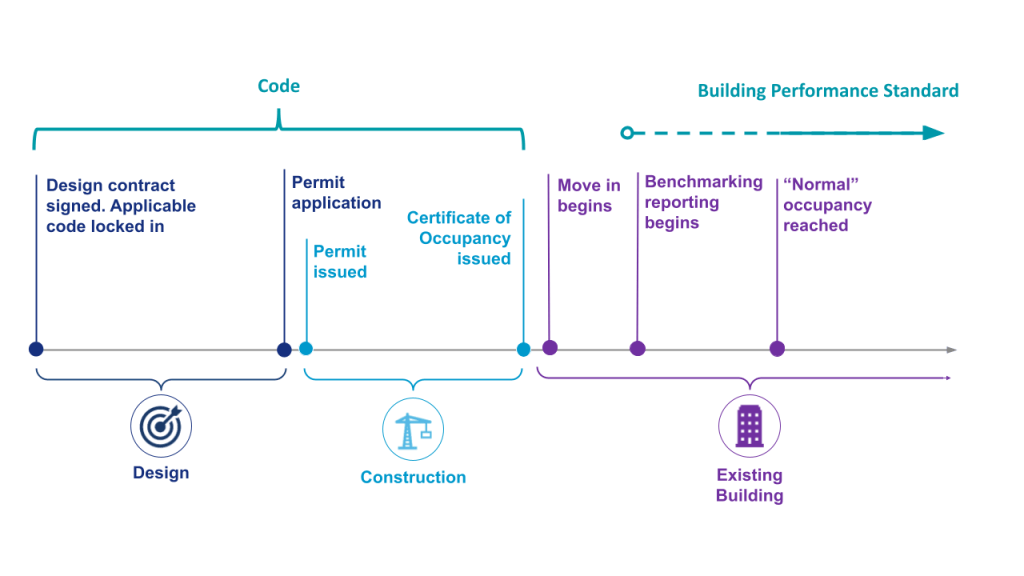
Historically, energy performance of buildings was regulated only for new construction and major renovations, through energy codes. Policymakers now increasingly recognize that to address the climate crisis and create healthy, thriving communities, we must also have policies which address the energy use of existing buildings.
Enter energy benchmarking requirements, and more recently building performance standards (BPS), which require improvements in energy and/or emissions from existing buildings. To date, nine U.S. localities and four U.S. states have enacted laws adopting BPS; most states have building codes for new construction and renovations derived from national model codes, with amendments, and many local governments do too. While out of sight and mind for most people, energy codes have a big impact on the health of residents, productivity of workers, and resilience. BPS policies can too, as we have covered in our Social Priorities in Building Performance series.
For more on the key ways BPS and codes differ, and how these differences explain what makes a BPS unique, see our recent fact sheet: “What defines a Building Performance Standard? For more details on the the code development and adoption process, check out our Code Adoption Toolkit Part 1 and Part 2.
To date, different governing authorities or agencies, and development and enforcement processes have kept BPS (affecting existing buildings) and energy codes (affecting new construction and renovations) separate. The fundamental problem is that all new buildings become existing buildings—and must then comply with existing building policies. This can prove a rude awakening for building owners whose new property, while compliant with energy codes, may not meet the building performance standards that will be enforced in a few years. BPS policies often not only have different performance expectations than the energy code, but also may use different metrics, define buildings differently, or vary in other ways that complicate planning. Alignment is important to ensure that all buildings are providing the same energy and health benefits to their occupants, and that throughout the construction process policy requirements are clear to all actors, architect to asset manager. Yet getting to this alignment is challenging, often due to the same structures and patterns that created the policy separation in the first place.
We’ll be diving in further to understanding the challenges to alignment between BPS and codes through a new partnership with the National Energy Codes Collaborative, as discussed below. We invite you to join us on this important journey, and look out for additional resources in the coming months.
Aligning energy codes and BPS
How do buildings move from imagination to operation? At what point do buildings exit the realm of codes and enter the realm of BPS? Being familiar with this timeline is crucial to crafting effective policies that reduce unintended consequences for building owners and their occupants.

- The developer engages a team which spends anywhere from 6 months to 3+ years to design a building. It is early in this phase that the applicable code is actually locked in—in typical cases, it is the local code in place at the time of signing the design contract that the permit is measured against, rather than the code in place at the time of the permit request.
- Eventually the design drawings and energy models are submitted to the locality’s building permit approval process.
- Construction can only begin once the permit has been issued.
- For larger commercial and residential projects, construction can take several years. Completion is marked by the locality issuing a Certificate of Occupancy which confirms that a building is in compliance with the code and that occupants may move in.
- While it is possible that the building would become fully occupied immediately, the process to fill the building will often take a longer time period.
- Benchmarking requirements typically come into effect at the end of the first full calendar year after the Certificate of Occupancy is issued in order to capture sufficient data.
- If a building performance standard exists, it will kick in 1 or more years thereafter, depending on how the policy defines covered existing buildings. It can take up to 3 years for a building to reach a “normal” or “stable” level of occupancy, which, as we’ll discuss below, is important for fairly applying performance standards.
But what is performance?
Perhaps nothing typifies the division between codes and BPS better than their differing uses of the word “performance.”
Building codes evaluate compliance using either a prescriptive pathway, or a performance pathway that compares modeled performance to a modeled baseline—these code compliance models are developed in the design phase and submitted with the permit. Thus, for codes, the “performance” path means modeled performance based on an energy model. BPS policies, on the other hand, are “outcome-based” policies, which evaluate compliance based on measured, verified, real-world performance like energy bills.
The awkward truth is that actual energy use outcomes rarely match the energy model. Indeed, most energy modelers will tell you that predicting outcomes is not the purpose of a “code compliance model.” Plans tend to change throughout the multi-year design and construction process; what is designed is almost never exactly what is built. In theory, an additional “as built” energy model should be created, but this rarely happens, and jurisdictions do not have a standardized process to ensure that completed buildings will actually meet energy performance requirements. Moreover, few buildings are commissioned and operated exactly as the designers assumed.
Because code officials’ authority ends after the certificate of occupancy is issued (and is only once again triggered by major renovations or equipment replacements), there is no ongoing check on buildings’ performance, and compliance now means compliance forever/until the next major renovation. BPS policies, on the other hand, not only evaluate actual performance, but typically ratchet up performance targets over time to drive continued improvement in the building stock. Comparing code performance and BPS performance is further complicated by differing metrics. To date, the national model energy codes measure performance based on estimated energy costs, though several states have compliance pathways based on modeled annual or time-based energy use intensity. BPS policies, meanwhile, tend to use greenhouse gas emissions or site energy use intensity, though some use other metrics depending on policy priorities and differences in legal authority.

Existing, am I right?
Don’t worry, we’re not going to get all existential here. It sounds simple to say that codes are for new construction (and renovations), and BPS policies are for “existing” buildings. But the question of when and how a building becomes an “existing building” for the purpose of having to comply with a BPS is surprisingly complicated!
There are two key elements of a BPS that impact this question. The first is what if any language in the BPS defines when a newly constructed building must start complying with a BPS. The second element, which is influenced by the “when”, is how a newly constructed building complies with the BPS. Some BPS structures use fixed targets (e.g., Seattle), while others rely on some type of building-specific baseline (e.g., Montgomery County, Maryland) which introduces complications for new construction. For example, if compliance requires comparison to the last two years of building usage data, then it can be several years before a baseline for evaluating compliance can be established that fairly represents the building’s actual performance when fully occupied.
When newly constructed buildings must start complying with BPS could be based on a number of triggers: a set period of time after the certificate of occupancy, the availability of a certain number of years of data, occupancy thresholds, etc. The impact of each of these triggers may vary by when they fall within a BPS compliance period. Current BPS laws employ a number of definitions for codifying when newly constructed buildings are covered, and are even more silent on how—if they mention the issue at all. Potential pathways include standard benchmarking, energy modeling, or standardized reference data. In future resources we will highlight the benefits and challenges of each of these options and discuss factors that can influence the selection.
The costs of non-alignment
When codes and BPS are not aligned, new buildings face the risks of being out of compliance with a BPS soon after they cross over into being an “existing building.” In that case, the building owner could end up having to either make alternative compliance payments, or undertake unexpected, costly, and disruptive renovations within the first years of operation. As no BPS policy has reached its first compliance deadline yet, no building has yet experienced these consequences. One might assume that any new building will outperform any BPS, but studies by IMT and the New BuiIdings Institute (NBI) show that some new buildings may not comply even with the first BPS compliance cycle targets. Buildings that meet the first BPS interim standard are not out of the woods either; commercial HVAC equipment often lasts 20-30 years, and so a building built today might still need to prematurely replace equipment to meet a final 2040 or 2050 BPS deadline. The best and least expensive time to improve energy performance is when designing a building.
Charting a course
In the absence of codes that explicitly account for BPS, it is important to ensure that building performance policies send clear signals to encourage building owners and designers to plan for BPS compliance regardless of the code and to set clear expectations for how recently built buildings are treated. Moreover, as BPS policies become more common and standardized, there will also be opportunities for codes to consider performance outcomes. This blog post is an invitation to conversation about what that clarity looks like and the path towards creating an integrated building performance lifecycle.
Over 2024, IMT will release a series of resources covering additional aspects of the interaction between codes and BPS, and suggesting some solutions.

To dive in further, IMT is also excited to announce our role in the American Council for an Energy-Efficient Economy’s (ACEEE) National Energy Codes Collaborative, supported by the U.S. Department of Energy’s Resilient and Efficient Codes Implementation grant program. The Codes Collaborative is a new nationwide network that will empower states and jurisdictions to effectively and sustainably implement updated building energy codes and related policies through collaboration, capacity building, and technical assistance. IMT and ACEEE will jointly run a specific Technical Assistance Group (TAG) on “Aligning Codes and BPS.”
The Codes Collaborative and this Codes+BPS TAG will launch next week at the National Energy Codes Conference. For more on the Collaborative, and to get involved, see ACEEE’s collaborative webpage. Or reach out to us; we’d love to hear your thoughts!

